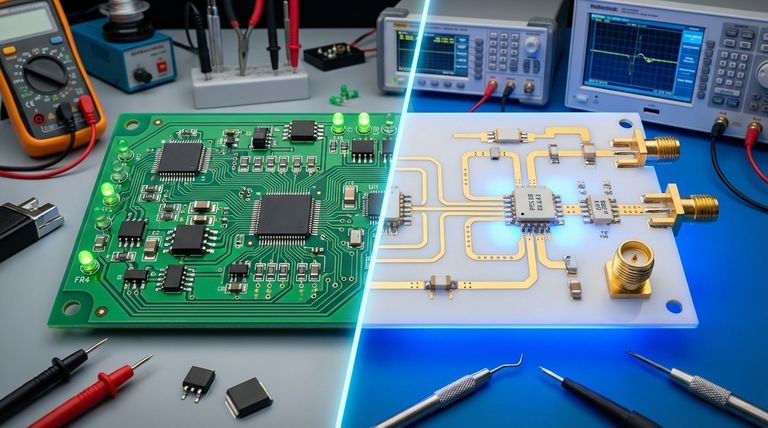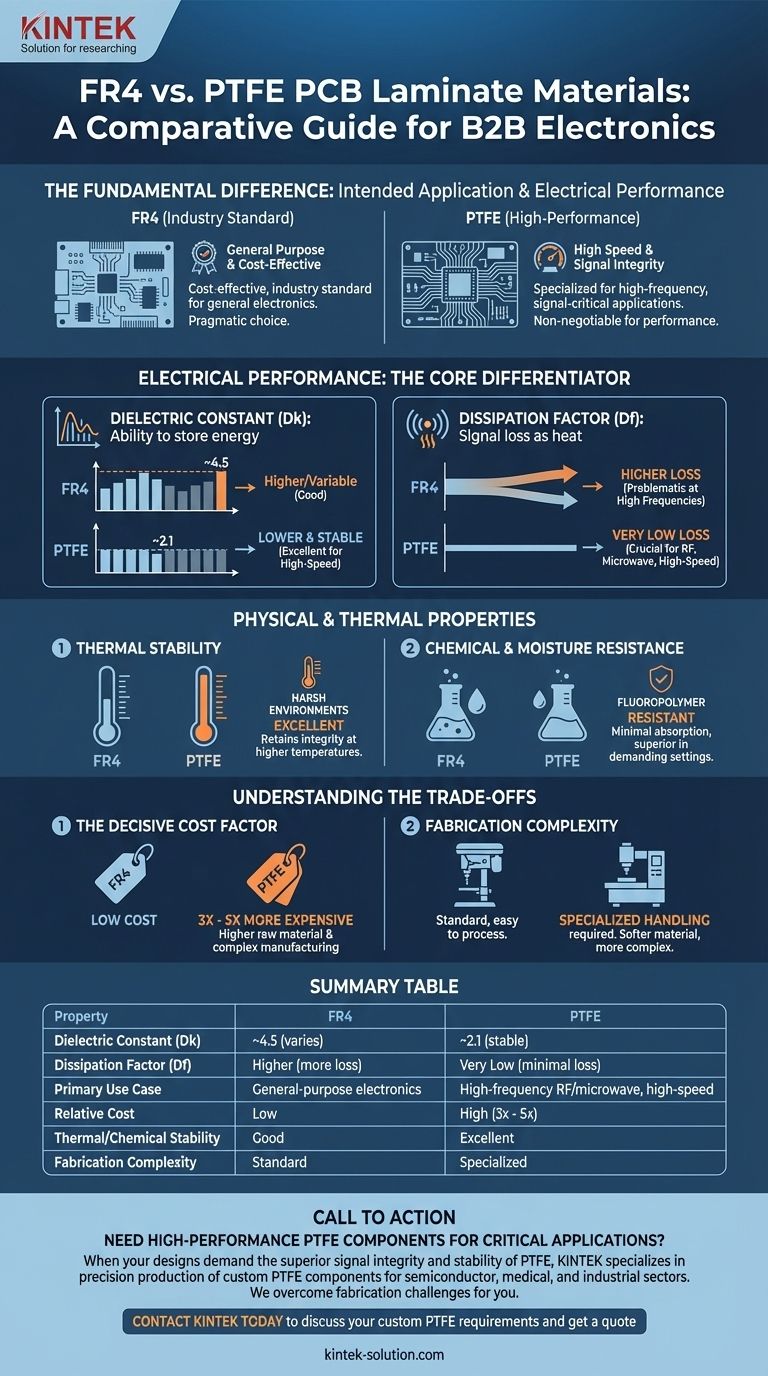The fundamental difference between FR4 and PTFE lies in their intended application and resulting electrical performance. FR4 is the cost-effective, industry-standard laminate for the vast majority of general-purpose electronics. PTFE, in contrast, is a specialized, high-performance material essential for applications where signal integrity at high speeds or high frequencies is the primary concern.
Choosing between FR4 and PTFE is not just a material selection; it's a strategic decision balancing your project's performance requirements against its budget. While FR4 is the pragmatic choice for most applications, PTFE becomes a non-negotiable necessity when signal integrity at high frequencies is paramount.

Electrical Performance: The Core Differentiator
The most critical differences between these two materials become apparent when analyzing how they handle electrical signals, especially as frequency increases.
Dielectric Constant (Dk)
The dielectric constant measures a material's ability to store electrical energy. For high-frequency applications, a lower and more stable Dk is highly desirable.
PTFE has a significantly lower Dk (around 2.1) compared to FR4 (around 4.5). More importantly, PTFE's Dk remains remarkably consistent across a wide range of frequencies, ensuring predictable performance for high-speed signals.
Dissipation Factor (Df)
The dissipation factor, or loss tangent, quantifies how much of a signal's energy is absorbed and lost as heat within the material.
PTFE exhibits a very low Df, meaning it absorbs minimal signal energy. This is crucial for maintaining signal strength in RF, microwave, and high-speed digital circuits. FR4 has a higher Df, leading to greater signal loss, which becomes problematic at higher frequencies.
Impact on High-Frequency Signals
These two properties combined dictate the material's suitability for advanced applications.
PTFE's low and stable Dk, along with its low Df, makes it the superior choice for any design where preserving the shape and strength of a high-frequency signal is critical for the circuit's function.
Physical and Thermal Properties
Beyond electrical characteristics, the physical nature of the materials influences their application in different environments.
Thermal Stability
PTFE offers excellent thermal stability, maintaining its structural and electrical integrity at higher temperatures than FR4. This makes it a reliable choice for applications in harsh thermal environments.
Chemical and Moisture Resistance
As a fluoropolymer, PTFE is inherently resistant to most chemicals and absorbs very little moisture. This provides a clear reliability advantage in demanding industrial or aerospace applications where environmental exposure is a concern.
Understanding the Trade-offs
Selecting a high-performance material like PTFE involves significant trade-offs that are essential to understand before making a decision.
The Decisive Cost Factor
The most significant barrier to using PTFE is its cost. A PTFE PCB can be 3 to 5 times more expensive than an equivalent board made from FR4.
This cost difference is driven by both the raw material price and the more complex manufacturing process required for PTFE.
Fabrication and Manufacturing
FR4 is a rigid, glass-epoxy laminate that is easy to drill, mill, and process using standardized, widely available equipment.
PTFE is a much softer material that requires specialized handling and manufacturing techniques. This complexity adds to the cost and can limit your choice of fabrication houses.
Making the Right Choice for Your Application
Your final decision should be guided by a clear understanding of your project's primary goal.
- If your primary focus is cost-effectiveness for standard applications: FR4 is the default, industry-standard choice, offering reliable performance for most digital and low-frequency analog circuits.
- If your primary focus is signal integrity for high-frequency RF/microwave circuits: PTFE is the necessary investment, as its low dielectric constant and minimal signal loss are critical for performance.
- If your primary focus is operation in harsh thermal or chemical environments: PTFE's superior stability and resistance provide a reliability advantage that can justify its higher cost.
- If your primary focus is high-speed digital design with strict impedance control: PTFE or other specialized high-speed laminates are essential to maintain signal integrity over long traces.
By understanding these core trade-offs, you can select the material that aligns perfectly with both your technical requirements and your project's financial constraints.
Summary Table:
| Property | FR4 | PTFE |
|---|---|---|
| Dielectric Constant (Dk) | ~4.5 (varies with frequency) | ~2.1 (stable with frequency) |
| Dissipation Factor (Df) | Higher (more signal loss) | Very Low (minimal signal loss) |
| Primary Use Case | Cost-effective, general-purpose electronics | High-frequency RF/microwave, high-speed digital |
| Relative Cost | Low (Industry Standard) | High (3x - 5x more expensive) |
| Thermal/Chemical Stability | Good | Excellent |
| Fabrication Complexity | Standard processes | Specialized handling required |
Need High-Performance PTFE Components for Your Critical Application?
When your designs demand the superior signal integrity and stability of PTFE, you need a manufacturing partner who understands the material's complexities. KINTEK specializes in the precision production of custom PTFE components—including seals, liners, and labware—for the semiconductor, medical, laboratory, and industrial sectors.
We help you overcome fabrication challenges and ensure your high-frequency or harsh-environment applications perform reliably. From prototypes to high-volume orders, we deliver the quality you need.
Contact KINTEK today to discuss your custom PTFE requirements and get a quote.
Visual Guide

Related Products
- Custom PTFE Parts Manufacturer for Teflon Parts and PTFE Tweezers
- Custom PTFE Parts Manufacturer for Teflon Containers and Components
- Custom PTFE Teflon Balls for Advanced Industrial Applications
- Customizable PTFE Rods for Advanced Industrial Applications
- PTFE Chemical Solvent Sampling Spoon
People Also Ask
- What design considerations are important for custom PTFE parts? Design for Performance & Reliability
- What fabrication services are available for PTFE? Shearing, Stamping, Laser Cutting, Molding & Machining
- What are the main applications of PTFE type Teflon? Unlock Its Versatility for Your Industry
- What factors should be considered when choosing between Nylon and PTFE? Select the Right Material for Your Application
- What finishing techniques are effective for machined Teflon parts? Achieve Functional Performance and Dimensional Stability



















